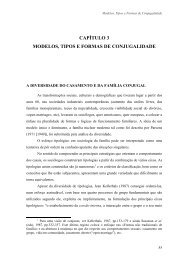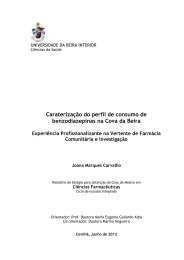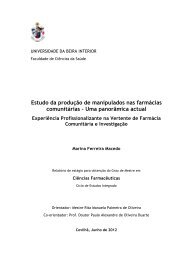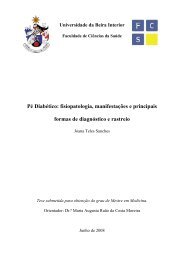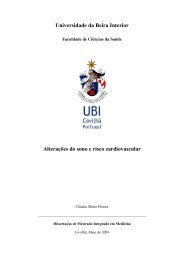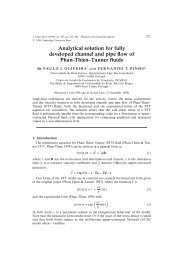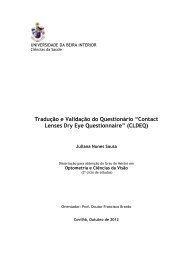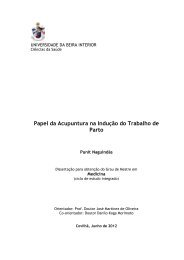Tese_Tânia Vieira.pdf - Ubi Thesis
Tese_Tânia Vieira.pdf - Ubi Thesis
Tese_Tânia Vieira.pdf - Ubi Thesis
Create successful ePaper yourself
Turn your PDF publications into a flip-book with our unique Google optimized e-Paper software.
Chapter I - Introduction<br />
materials (Yin et al. 2005; Guidelli et al. 2011). These special and unique properties could be<br />
attributed to their small sizes and large specific surface area (Guzman et al. 2011). All of this<br />
makes the inorganic nanoparticles adequate for applications in biomedicine, catalysis,<br />
electronics, energy science, magnetic, mechanics, optics, and so on (Shahverdi et al. 2007;<br />
Fayaz et al. 2010). A number of recent works in this field, describe the possibility of generating<br />
new types of nanostructured inorganic materials with designed surface and structural properties<br />
(Sondi et al. 2004). Thus, the preparation, characterization, surface modification, and<br />
functionalization of nanosized inorganic particles open the possibility to formulate a new<br />
generation of bactericidal materials to avoid microbial biofilm formation on biomaterials surface<br />
(Sondi et al. 2004; Lipovsky et al. 2011). Nanoparticles with antibacterial properties offer many<br />
distinctive advantages with respect to the therapy with antibiotics since they allow the reduction<br />
of in vivo toxicity, overcoming the problem of resistance to the antibiotics, and lowering the<br />
cost associated with their production (Huh et al. 2011).<br />
Among the different types of nanoparticles, the metallic ones are the most promising<br />
candidates for this purpose, since they show good antibacterial properties (Ruparelia et al. 2008;<br />
Rai et al. 2009), due to their high specific surface area, high fraction of surface atoms (Hung et<br />
al. 2007; Shahverdi et al. 2007; Martin et al. 2011), and small size. These properties allow<br />
nanoparticles to interact closely with cellular membranes of the bacteria. In addition to these<br />
characteristics, this kind of nanoparticles release metal ions in solution, which increases the<br />
antibacterial properties (Ruparelia et al. 2008). Another properties of these nanoparticles are<br />
the long life and the heat resistance (Potara et al. 2011). Well-known metallic nanoparticles<br />
with these properties are the silver nanoparticles (AgNPs).<br />
1.3. Silver Nanoparticles<br />
The unique antimicrobial properties of silver in the treatment of infections have been<br />
known for a long time (Gurunathan et al. 2009; Häntzschel et al. 2009; Mohammed Fayaz et al.<br />
2009). Since 1000 BC, Egyptians, Greeks, Romans and other ancient civilizations used silver<br />
vessels to store perishable foods, to produce silver cutlery, glassware and dishes (Vasilev et al.<br />
2010). Silver was also used with medical purposes for rheumatism, tetanus, gonorrhea and wound<br />
healing treatment (Vertelov et al. 2008). In the 18 th century, silver nitrate (AgNO 3 ) was used for<br />
the treatment of venereal diseases, fistulae from salivary glands, bone abscesses (Rai et al.<br />
2009), and ulcers (Neal 2008). Dilute solutions of AgNO 3 have been used since the 19 th century in<br />
treatment of infections and burns (Ip et al. 2006). Due to the successful of the registered cases,<br />
in 1920s silver was recognized by the United States Food and Drug Administration for its<br />
antimicrobial activity and was regulated for wound management (Neal 2008). In 1940s, after<br />
penicillin was introduced in the market, the use of silver for the treatment of bacterial<br />
infections was reduced (Rai et al. 2009). Silver reappear again in the 1960s when Moyer<br />
introduced the use of 0.5% AgNO 3 for the treatment of burns as previously done in the 19 th<br />
7




